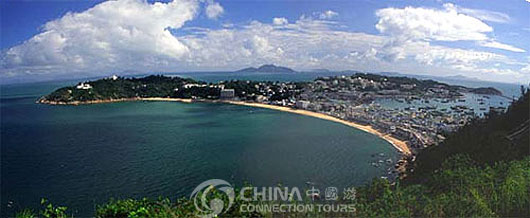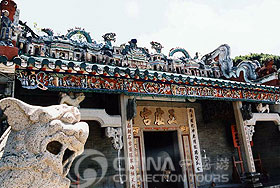

The shape of the Cheung Chau Island is like a dump bell, which is situated to the west of Hong Kong. Despite its minuscule size of just 2.5 square kilometers, Cheung Chau is the most crowded of all the outlying islands, with a population of some 30,000.
And also it is Hong Kong's largest fishing island, each May sees floating children and towers of lucky buns; the world's only Bun Festival, At a quarter to midnight a paper effigy of the King of the Ghosts is set on fire, giant incense sticks are lit and the buns are harvested and distributed to the villagers, who, delighted to be sharing in this auspicious good fortune, celebrate late into the night.
It has preserved the style of old day fishing port with natural beauty. The east bay water is crystal clear and sand fresh, an ideal spot of taking sea bath.
The origins of this Taoist rite can be traced back hundreds of years to the Qing Dynasty (1644-1911), when Cheung Chau was devastated by a storm, followed by an outbreak of the plague which claimed many lives. Believing the island to be haunted, the locals performed a sacrificial ceremony to placate the Gods and pray for their favor. The festival is now timed to coincide with Buddha's birthday.
The people of the island eat a vegetarian diet for the three days prior to the main procession, when 16-metre high bamboo towers are erected in front of the Pak Tai temple and studded with thousands of steaming buns as an offering to the ancient Chinese spirits. The buns are thought to ensure smooth sailing for the fishing boats and bring good fortune and plentiful catches.
No Chinese festival is complete without lion and dragon dancers, but this island's quirk is the children dressed as mythological and modern heroes suspended above the crowds on the tips of swords and paper fans. They form the float procession of Piaose and are all safely secured within steel frames, though they appear to glide through the air. The airborne children hardly move and their eyes can be half closed, not because they are in a state of Nirvana but because they are often drugged so as to endure the ceremonies. Though such treatment of children may be disturbing to a Western mindset it is such a unique festival that anthropologists are drawn to it every year and parents consider it a great honor for their offspring to be part of the procession.
 The Pak Tai Temple (Lord of north and patron of Cheung Chau Island) was built in 1783 on this island, inside which are kept an ancient sword and a one hundred year old wood bridge. The annual Taoist Ritual Tour of Peace and Eliminating Calamities, Piao Se and Bao San fairs are all held here. The Taoist Ritual Tour of Peace and Eliminating Calamities is a traditional religious activity whose original meaning is to offer thanks to god for blessings and protecting peace and to release souls from purgatory.
The Pak Tai Temple (Lord of north and patron of Cheung Chau Island) was built in 1783 on this island, inside which are kept an ancient sword and a one hundred year old wood bridge. The annual Taoist Ritual Tour of Peace and Eliminating Calamities, Piao Se and Bao San fairs are all held here. The Taoist Ritual Tour of Peace and Eliminating Calamities is a traditional religious activity whose original meaning is to offer thanks to god for blessings and protecting peace and to release souls from purgatory.
There is a cave on the island along the hill top road outward to the other end, which is called 'Zhang Bao Chai Cave'. It is said that in the 19th century, pirate Zhang Bal Chai hid his treasure in this cave, inside which the path is narrow with darkness all around and only a ray of light on top called sky of a ray. Those who are interested in exploration may come and have a look.

